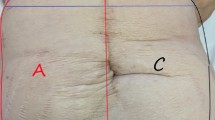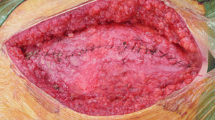Abstract
Introduction
In the Transversus Abdominis Release (TAR) procedure, ideally, the posterior sheath is completely reapproximated to establish an interface isolating the polypropylene mesh from visceral contents. When primary closure of the posterior sheath is unachievable, Vicryl mesh is commonly used to supplement the posterior sheath closure and an uncoated polypropylene mesh is placed superficial to the Vicryl mesh. The long-term implications of utilizing Vicryl mesh as an antiadhesive barrier are poorly understood. In this study, we aimed to assess our outcomes when utilizing Vicryl mesh to supplement the posterior sheath defects when placed underneath polypropylene mesh in patients undergoing posterior component separation.
Methods
Adult patients who underwent VHR with concurrent TAR procedure with a permanent synthetic mesh and posterior sheath supplementation with Vicryl mesh in the Cleveland Clinic Center for Abdominal Core Health between January 2014 and December 2022 were queried retrospectively from a prospectively collected database in the Abdominal Core Health Quality Collaborative. We evaluated 30-day wound morbidity, perioperative complications, long-term mesh-related complications, and pragmatic hernia recurrence.
Results
53 patients who underwent TAR procedure with posterior sheath supplementation using Vicryl mesh and had a minimum 12-month follow-up were identified. Of the 53 patients, 94.3% presented with recurrent hernias, 73.6% had a midline hernia, 7.5% had a flank hernia, and 18.9% had concurrent parastomal hernia. The mean hernia width was 24.9 cm (± 8.8 cm). No Vicryl mesh-related operative complications were identified in our study, with no instances of mesh erosion, fistulas, or interventions for small bowel obstruction. Skin necrosis requiring reoperations was observed in three patients (5.7%), leading to permanent mesh excision in two cases (3.8%) without intraabdominal visceral involvement. Throughout the 12-month follow-up, 23 incidences (43.4%) of surgical site occurrences (SSOs) and surgical site occurrences requiring procedural intervention (SSOPI) were documented.
Conclusions
Our findings suggest that posterior sheath supplementation with Vicryl mesh is a feasible approach to achieve posterior sheath closure in challenging abdominal wall reconstruction cases. Given the absence of notable mesh-related complications and a similar hernia recurrence rate to cases without posterior sheath supplementation, Vicryl mesh can be used to safely achieve posterior sheath closure in complex reconstructions with insufficient native tissue.
Similar content being viewed by others
Data availability
The data supporting this study's findings are available upon reasonable request from the corresponding author. Restrictions apply to the availability of these data, which were used under license for this study, and so are not publicly available. However, data are available from the authors upon reasonable request and with permission of the data custodian.
References
Messer N, Rosen MJ (2023) Ventral hernia repair: does mesh position matter? Surg Clin North Am 103:935–945. https://doi.org/10.1016/j.suc.2023.04.005
Novitsky YW, Elliott HL, Orenstein SB, Rosen MJ (2012) Transversus abdominis muscle release: a novel approach to posterior component separation during complex abdominal wall reconstruction. Am J Surg 204:709–716. https://doi.org/10.1016/j.amjsurg.2012.02.008
Carbonell AM (2008) Interparietal hernias after open retromuscular hernia repair. Hernia J Hernias Abdom Wall Surg 12:663–666. https://doi.org/10.1007/s10029-008-0393-x
Winder JS, Majumder A, Fayezizadeh M et al (2018) Outcomes of utilizing absorbable mesh as an adjunct to posterior sheath closure during complex posterior component separation. Hernia 22:303–309. https://doi.org/10.1007/s10029-018-1732-1
Goldstein AL, Nevo N, Nizri E et al (2023) The use of inlay bridge of the posterior fascia as adjuvants to a modified rives-stoppa repair for difficult abdominal wall hernias. Am Surg 89:4616–4624. https://doi.org/10.1177/00031348221114027
Campanelli G, Bastazza M, Ruca A et al (2000) Surgical treatment of incisional hernias with marked loss of substance. Hernia 4:202–205. https://doi.org/10.1007/BF01201067
van’t Riet M, de Van van Steenwijk PJ, Bonjer HJ et al (2007) Mesh repair for postoperative wound dehiscence in the presence of infection: is absorbable mesh safer than non-absorbable mesh? Hernia J Hernias Abdom Wall Surg 11:409–413. https://doi.org/10.1007/s10029-007-0240-5
Wang TY, Elliott R, Low DW (2013) Damage control abdomen: single-stage reconstruction using a vicryl mesh buttress. Ann Plast Surg 70:324–330. https://doi.org/10.1097/SAP.0b013e3182361af9
Fafaj A, Tastaldi L, Alkhatib H et al (2021) Management of ventral hernia defect during enterocutaneous fistula takedown: practice patterns and short-term outcomes from the abdominal core health quality collaborative. Hernia 25:1013–1020. https://doi.org/10.1007/s10029-020-02347-8
Haskins IN, Horne CM, Krpata DM et al (2018) A call for standardization of wound events reporting following ventral hernia repair. Hernia 22:729–736. https://doi.org/10.1007/s10029-018-1748-6
Mathias JM (1998) CDC updates guideline on surgical site infection. OR Manager 14:9–10
Krpata DM, Petro CC, Prabhu AS et al (2021) Effect of hernia mesh weights on postoperative patient-related and clinical outcomes after open ventral hernia repair: a randomized clinical trial. JAMA Surg 156:1085–1092. https://doi.org/10.1001/jamasurg.2021.4309
Baucom RB, Ousley J, Feurer ID et al (2016) Patient reported outcomes after incisional hernia repair-establishing the ventral hernia recurrence inventory. Am J Surg 212:81–88. https://doi.org/10.1016/j.amjsurg.2015.06.007
Zolin SJ, Krpata DM, Petro CC et al (2023) Long-term clinical and patient-reported outcomes after transversus abdominis release with permanent synthetic mesh: a single center analysis of 1203 patients. Ann Surg 277:e900–e906. https://doi.org/10.1097/SLA.0000000000005443
Messer N, Melland MS, Miller BT et al (2023) Evaluating the impact of lifting mandatory smoking cessation prior to elective abdominal wall reconstruction. A Single-Center Exp Am J Surg S0002–9610(23):00442–00447. https://doi.org/10.1016/j.amjsurg.2023.09.013
Rosen MJ, Krpata DM, Petro CC et al (2022) Biologic vs synthetic mesh for single-stage repair of contaminated ventral hernias: a randomized clinical trial. JAMA Surg 157:293–301. https://doi.org/10.1001/jamasurg.2021.6902
Liu L, Petro C, Majumder A et al (2016) The use of Vicryl mesh in a porcine model to assess its safety as an adjunct to posterior fascial closure during retromuscular mesh placement. Hernia J Hernias Abdom Wall Surg 20:289–295. https://doi.org/10.1007/s10029-016-1469-7
Funding
This research did not receive any specific grant from funding agencies in the public, commercial, or not-for-profit sectors.
Author information
Authors and Affiliations
Contributions
All the authors contributed to the study's conception and design. Material preparation and data collection were performed by RCE and NM. The manuscript was written by NM and MJR. All the authors commented on and revised the manuscript. All the authors read and approved the final manuscript. The study was supervised by MJR.
Corresponding author
Ethics declarations
Conflict of interest
I declare that there are no conflicts of interest related to this manuscript. The study was conducted impartially, and the findings presented in the manuscript are based solely on the analysis and interpretation of the data. M.J.R receives salary support for his position in the leadership of the Abdominal Core Health Quality Collaborative (ACHQC), which is the data source for the present submission, and he receives board member support and stock options from Ariste Medical. He also has a research grant paid to his institution by Tela Bio for a clinical trial. A.S.P. has received funding paid to her institution from Intuitive Surgical Inc. and personal fees from Medtronic, Intuitive Surgical, CMR Surgical, and Verb Surgical. L.R.B has received an honorarium from Intuitive.
Ethical approval
The research was conducted in accordance with the ethical principles outlined in the Institutional Review Board. The use of data and materials was carried out with proper authorization and in compliance with all applicable laws and regulations.
Informed consent
As this study involved the use of existing data and did not involve direct interaction with human subjects, no patients were enrolled, and therefore, no informed consent was required. The data used in this research were anonymized and de-identified, ensuring the privacy and confidentiality of individuals in accordance with the Institutional Review Board.
Human and animal rights
The present article does not incorporate studies directly involving human participants, as it constitutes a review of preexisting data sourced from a hernia database.
Additional information
Publisher's Note
Springer Nature remains neutral with regard to jurisdictional claims in published maps and institutional affiliations.
Supplementary Information
Below is the link to the electronic supplementary material.
Rights and permissions
Springer Nature or its licensor (e.g. a society or other partner) holds exclusive rights to this article under a publishing agreement with the author(s) or other rightsholder(s); author self-archiving of the accepted manuscript version of this article is solely governed by the terms of such publishing agreement and applicable law.
About this article
Cite this article
Messer, N., Miller, B.T., Beffa, L.R.A. et al. Outcomes of posterior sheath supplementation with Vicryl mesh in TAR—a single-center study. Hernia (2024). https://doi.org/10.1007/s10029-024-03054-4
Received:
Accepted:
Published:
DOI: https://doi.org/10.1007/s10029-024-03054-4




